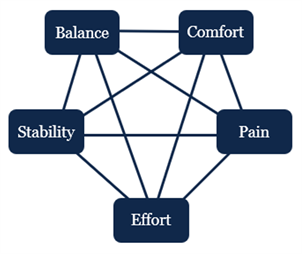Developing Metrics of Success for Exoskeleton Evaluation
Motivation
The minimum threshold of perceivable lower limb exoskeleton assistance is larger than the assistance provided by most state-of-the-art devices, which are typically designed to reduce the wearers’ metabolic rate. This indicates that people are largely insensitive to metabolic benefits provided by these assistive devices, and the failure to perceive these benefits may impact adoption and use within society. This motivates the need for a metric that can capture exoskeleton performance along additional dimensions – ergonomics, comfort, and stability – to drive designs that users value in a holistic sense.

Our Nature Communications paper was recently selected as an Editor’s Choice article, highlighting the potential of our approach as one of the top studies published in the journal.
Approach
By leveraging concepts from behavioral economics and wearable robotics, we have recently developed a novel metric – termed Marginal Value (MV) – to quantify exoskeleton success using the dollar ($) value of its assistance to wearers.

To obtain the value of exoskeleton use i.e. MV, participants complete 2-minute uphill walking bouts during which they assign a dollar value to the effort of walking. To ensure honesty of reported dollar values, participants engage in a sellers Vickrey second-price auction, commonly used in economics. While engaging in this auction, participants compete against automated agents (robo-bidders) modeled on human fatigue behavior instead of real competing participants. Over time, the reported dollar values (bids) create a profile (price-to-walk curve) which reflects the wearer’s cost of uphill walking. These task cost profiles can be generated for several wearer conditions: with exoskeleton assistance, without assistance, and without an exoskeleton entirely. We posit that if the exoskeleton offers meaningful assistance to the wearer during a strenuous task, its value can be quantified by the reduction in bids or compensation required for each walking bout.
Our hope is that a metric aimed at capturing perceived value of exoskeletons can be used in tandem with physiological objectives to develop more impactful designs in the future.
To learn more about this metric, check out this video: https://mediaspace.wisc.edu/id/1_rpikd0n7?width=649&height=401&playerId=34298531&st=0&ed=703

Contributors: Nundini Rawal, Roberto Leo Medrano, Gray C. Thomas, Elliott Rouse
Publications
Medrano, R.L., Thomas, G.C. & Rouse, E.J. Can humans perceive the metabolic benefit provided by augmentative exoskeletons?. J NeuroEngineering Rehabil 19, 26 (2022). https://doi.org/10.1186/s12984-022-01002-w
Medrano, R.L., Thomas, G.C., Margolin, D. et al. The economic value of augmentative exoskeletons and their assistance. Commun Eng 2, 43 (2023). https://doi.org/10.1038/s44172-023-00091-2
N. D. Rawal, R. L. Medrano, G. C. Thomas and E. J. Rouse, “A Sensitivity Analysis of an Economic Value Metric for Quantifying the Success of Lower-Limb Exoskeletons and Their Assistance,” 2023 IEEE/RSJ International Conference on Intelligent Robots and Systems (IROS), Detroit, MI, USA, 2023, pp. 4168-4175, doi: 10.1109/IROS55552.2023.10342452.
